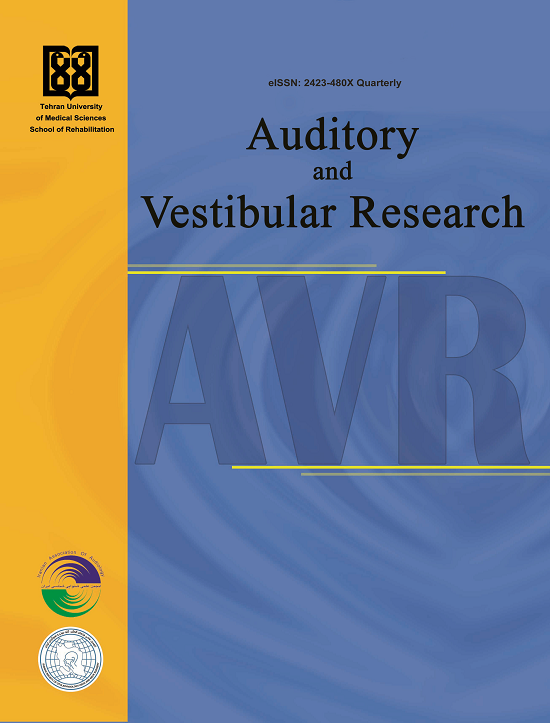A Persian cross-cultural validation and adaptation of the Hearing Implant Sound Quality Index Questionnaire for cochlear implant adult users
Abstract
Background and Aim: Cochlear implants (CIs) successfully improve speech and auditory skills for patients with a severe‑to‑profound degree of hearing loss. The psychometric properties of the Hearing Implant Sound Quality Index Persian version (P‑HISQUI19) were examined to measure auditory benefits in CI recipients in everyday life.
Methods: Seventy post-lingual CI users, aged 18-64 years, completed the P‑HISQUI19. Cross‑cultural adaptation of the P‑HISQUI19 was performed. Internal consistency and test–retest reliability were measured by Cronbach’s α and intra‑class correlation coefficients. The content and construct validity of the questionnaire were also examined.
Results: The P‑HISQUI19 average total score in implanted cases was 78.22, representing a moderate sound quality. The P‑HISQUI19 indicated excellent internal consistency reliability (Guttman’s split‑half‑coefficient = 0.912; Cronbach’s α =0.956) and test–retest reliability (r = 0.962). Our data proceeded to factor analysis, and the questionnaire items were loaded on three factors. In addition, factors such as age at implantation, duration of deafness, side of implantation, and gender factors did not significantly affect sound quality perception.
Conclusion: The P‑HISQUI19 is a valid and reliable measure, which should be beneficial in both research and clinical settings for evaluating the auditory benefits of those using CI during listening.
2. Holden LK, Finley CC, Firszt JB, Holden TA, Brenner C, Potts LG, et al. Factors affecting open-set word recognition in adults with cochlear implants. Ear Hear. 2013;34(3):342-60. [DOI:10.1097/AUD.0b013e3182741aa7]
3. Dunn CC, Walker EA, Oleson J, Kenworthy M, Van Voorst T, Tomblin JB, et al. Longitudinal speech perception and language performance in pediatric cochlear implant users: the effect of age at implantation. Ear Hear. 2014;35(2):148-60. [DOI:10.1097/AUD.0b013e3182a4a8f0]
4. Caldwell MT, Jiam NT, Limb CJ. Assessment and improvement of sound quality in cochlear implant users. Laryngoscope Investig Otolaryngol. 2017;2(3):119-24. [DOI:10.1002/lio2.71]
5. Zhang F, Underwood G, McGuire K, Liang C, Moore DR, Fu QJ. Frequency change detection and speech perception in cochlear implant users. Hear Res. 2019;379:12-20. [DOI:10.1016/j.heares.2019.04.007]
6. Roy AT, Carver C, Jiradejvong P, Limb CJ. Musical Sound Quality in Cochlear Implant Users: A Comparison in Bass Frequency Perception Between Fine Structure Processing and High-Definition Continuous Interleaved Sampling Strategies. Ear Hear. 2015;36(5):582-90. [DOI:10.1097/AUD.0000000000000170]
7. Gilbert M, Jiradejvong P, Limb C. Effect of Compression on Musical Sound Quality in Cochlear Implant Users. Ear Hear. 2019;40(6):1368-75. [DOI:10.1097/AUD.0000000000000715]
8. Mertens G, Kleine Punte A, De Bodt M, Van de Heyning P. Sound quality in adult cochlear implant recipients using the HISQUI19. Acta Otolaryngol. 2015;135(11):1138-45. [DOI:10.3109/00016489.2015.1066934]
9. Calvino M, Gavilán J, Sánchez-Cuadrado I, Pérez-Mora RM, Muñoz E, Lassaletta L. Validation of the Hearing Implant Sound Quality Index (HISQUI19) to assess Spanish-speaking cochlear implant users' auditory abilities in everyday communication situations. Acta Otolaryngol. 2016;136(1):48-55. [DOI:10.3109/00016489.2015.1086021]
10. Amann E, Anderson I. Development and validation of a questionnaire for hearing implant users to self-assess their auditory abilities in everyday communication situations: the Hearing Implant Sound Quality Index (HISQUI19). Acta Otolaryngol. 2014;134(9):915-23. [DOI:10.3109/00016489.2014.909604]
11. Caporali PF, Caporali SA, Bucuvic ÉC, Vieira Sde S, Santos ZM, Chiari BM. Cross cultural translation and adaptation to Brazilian Portuguese of the Hearing Implant Sound Quality Index Questionnaire - (HISQUI19). Codas. 2016;28(4):345-54. English, Portuguese. [DOI:10.1590/2317-1782/20162015119]
12. Cicek Cinar B, Koc MK, Baran COZ, Ozses M, Amann E. Validity and reliability of the Turkish version of the hearing implant sound quality index questionnaire (HISQUI19). Cochlear Implants Int. 2024;25(4):298-307. [DOI:10.1080/14670100.2024.2401239]
13. Aaronson NK, Acquadro C, Alonso J, Apolone G, Bucquet D, Bullinger M, et al. International Quality of Life Assessment (IQOLA) Project. Qual Life Res. 1992;1(5):349-51. [DOI:10.1007/BF00434949]
14. Lawshe CH. A quantitative approach to content validity. Pers psychol. 1975;28(4):563-75.
15. Caldwell M, Rankin SK, Jiradejvong P, Carver C, Limb CJ. Cochlear implant users rely on tempo rather than on pitch information during perception of musical emotion. Cochlear Implants Int. 2015;16 Suppl 3:S114-20. [DOI:10.1179/1467010015Z.000000000265]
16. Caldwell MT, Jiradejvong P, Limb CJ. Impaired Perception of Sensory Consonance and Dissonance in Cochlear Implant Users. Otol Neurotol. 2016;37(3):229-34. [DOI:10.1097/MAO.0000000000000960]
17. McDermott HJ. Music perception with cochlear implants: a review. Trends Amplif. 2004;8(2):49-82. [DOI:10.1177/108471380400800203]
18. Roy AT, Jiradejvong P, Carver C, Limb CJ. Assessment of sound quality perception in cochlear implant users during music listening. Otol Neurotol. 2012; 33(3): 319-27.
| Files | ||
| Issue | Articles in Press | |
| Section | Research Article(s) | |
| Keywords | ||
| Adult cochlear implant Persian Sound quality | ||
| Rights and permissions | |

|
This work is licensed under a Creative Commons Attribution-NonCommercial 4.0 International License. |






